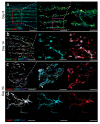Ultrasonic Based Tissue Modelling and Engineering
- PMID: 30441752
- PMCID: PMC6266922
- DOI: 10.3390/mi9110594
Ultrasonic Based Tissue Modelling and Engineering
Abstract
Systems and devices for in vitro tissue modelling and engineering are valuable tools, which combine the strength between the controlled laboratory environment and the complex tissue organization and environment in vivo. Device-based tissue engineering is also a possible avenue for future explant culture in regenerative medicine. The most fundamental requirements on platforms intended for tissue modelling and engineering are their ability to shape and maintain cell aggregates over long-term culture. An emerging technology for tissue shaping and culture is ultrasonic standing wave (USW) particle manipulation, which offers label-free and gentle positioning and aggregation of cells. The pressure nodes defined by the USW, where cells are trapped in most cases, are stable over time and can be both static and dynamic depending on actuation schemes. In this review article, we highlight the potential of USW cell manipulation as a tool for tissue modelling and engineering.
Keywords: acoustic trapping; acoustofluidics; microfluidics; tissue engineering; tissue modelling; ultrasonic manipulation.
Conflict of interest statement
The authors declare no conflicts of interest.
Figures








Similar articles
-
Proliferation and viability of adherent cells manipulated by standing-wave ultrasound in a microfluidic chip.Ultrasound Med Biol. 2007 Jan;33(1):145-51. doi: 10.1016/j.ultrasmedbio.2006.07.024. Ultrasound Med Biol. 2007. PMID: 17189057
-
Temperature-controlled MPa-pressure ultrasonic cell manipulation in a microfluidic chip.Lab Chip. 2015 Aug 21;15(16):3341-9. doi: 10.1039/c5lc00490j. Lab Chip. 2015. PMID: 26156858
-
Forthcoming Lab on a Chip tutorial series on acoustofluidics: acoustofluidics-exploiting ultrasonic standing wave forces and acoustic streaming in microfluidic systems for cell and particle manipulation.Lab Chip. 2011 Nov 7;11(21):3579-80. doi: 10.1039/c1lc90058g. Epub 2011 Sep 26. Lab Chip. 2011. PMID: 21952310 No abstract available.
-
Acoustofluidic platforms for particle manipulation.Electrophoresis. 2022 Apr;43(7-8):804-818. doi: 10.1002/elps.202100291. Epub 2021 Nov 12. Electrophoresis. 2022. PMID: 34719049 Review.
-
Acoustofluidics - changing paradigm in tissue engineering, therapeutics development, and biosensing.Lab Chip. 2023 Mar 1;23(5):1300-1338. doi: 10.1039/d2lc00439a. Lab Chip. 2023. PMID: 36806847 Review.
Cited by
-
Influence of High-Intensity Focused Ultrasound (HIFU) Ablation on Arteries: Ex Vivo Studies.Micromachines (Basel). 2021 Apr 25;12(5):485. doi: 10.3390/mi12050485. Micromachines (Basel). 2021. PMID: 33922879 Free PMC article.
-
Improved functionality of hepatic spheroids cultured in acoustic levitation compared to existing 2D and 3D models.Sci Rep. 2024 Sep 14;14(1):21528. doi: 10.1038/s41598-024-72059-x. Sci Rep. 2024. PMID: 39277635 Free PMC article.
-
Ultrasound-Responsive Systems as Components for Smart Materials.Chem Rev. 2022 Mar 9;122(5):5165-5208. doi: 10.1021/acs.chemrev.1c00622. Epub 2021 Nov 12. Chem Rev. 2022. PMID: 34767350 Free PMC article. Review.
-
Enhancing metabolic activity and differentiation potential in adipose mesenchymal stem cells via high-resolution surface-acoustic-wave contactless patterning.Microsyst Nanoeng. 2022 Jul 12;8:79. doi: 10.1038/s41378-022-00415-w. eCollection 2022. Microsyst Nanoeng. 2022. PMID: 35846175 Free PMC article.
-
Acoustic and Magnetic Stimuli-Based Three-Dimensional Cell Culture Platform for Tissue Engineering.Tissue Eng Regen Med. 2023 Jul;20(4):563-580. doi: 10.1007/s13770-023-00539-8. Epub 2023 Apr 13. Tissue Eng Regen Med. 2023. PMID: 37052782 Free PMC article. Review.
References
-
- Laurell T., Lenshof A. Microscale Acoustofluidics. Royal Society of Chemistry; London, UK: 2014.
Publication types
LinkOut - more resources
Full Text Sources

